Experiences refined for people
Experiences refined for people
Looking up information on a search engine was the most common action internet users took after seeing an ad online (e.g., display) and offline (e.g., TV).
As advertisers prioritize high-ROI tactics like paid search amid economic uncertainty, the versatility of paid ads remains a well-positioned option for businesses seeking to maximize their marketing budgets and generate quick revenue.
In this guide, we’ll review what paid search advertising is, why you should use it in your marketing strategy this year, and offer a few successful paid search campaign examples.
Paid search advertising is a form of PPC (pay-per-click) advertising where advertisers bid on keywords to display their ads on search engine results pages (e.g. Google, Bing, etc).
For example, if you search for a keyword like “best microwave,” this shows up in Google’s search results:
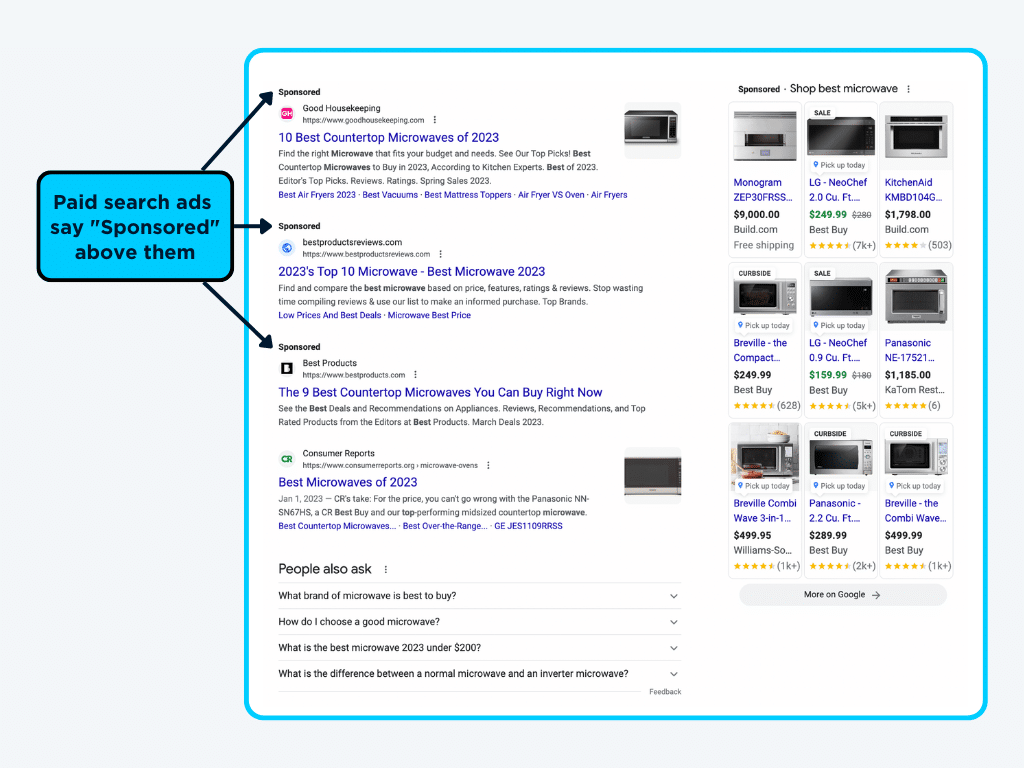
The posts underneath the word “Sponsored” are all paid search ad examples. Since Google’s continuous scroll update, paid search ads now also load between organic listings to blend in amidst traditional search results for a seamless and inconspicuous scrolling experience.
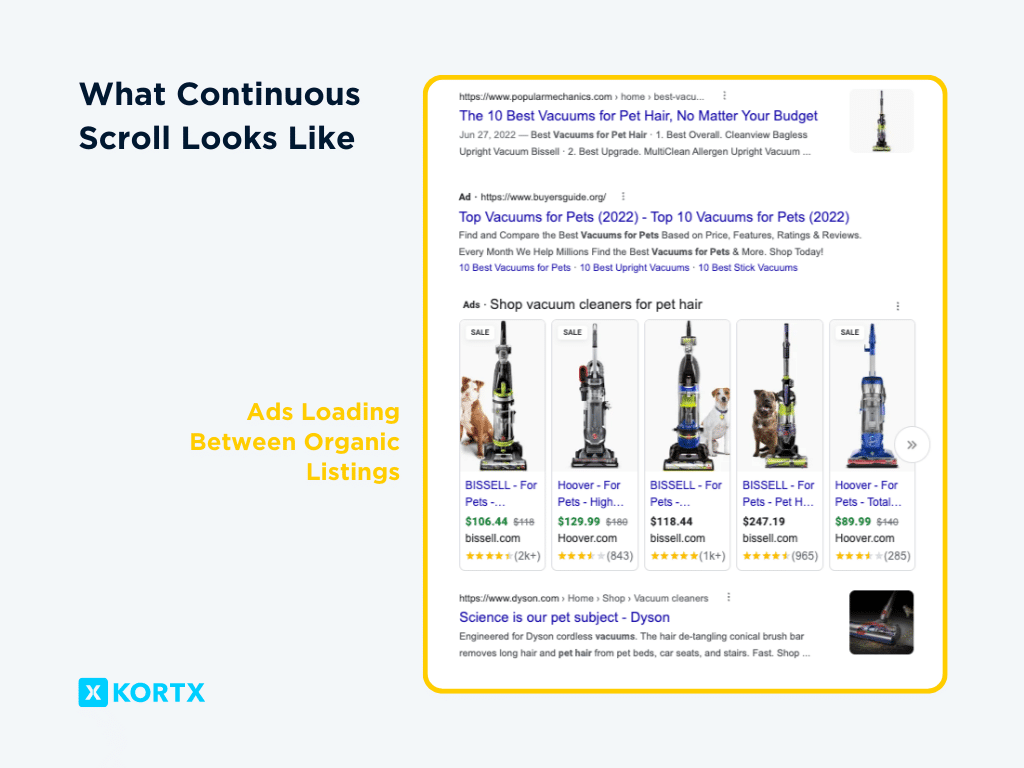
Our team of experts can help you develop and execute a winning strategy that aligns with your business objectives and delivers measurable results.
The three most common types of paid search ads are:
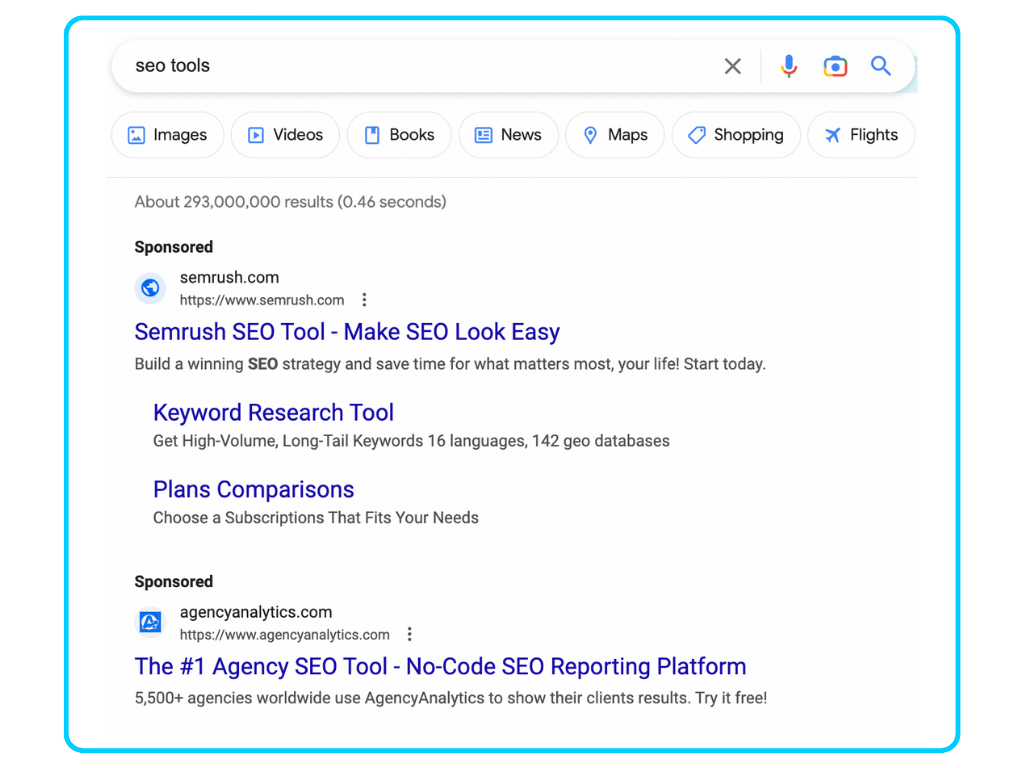
These are the most common type of paid search ads, which appear at the top of search engine results pages (SERPs) with a headline, description, and URL.
When users search for specific products or services, these ads showcase products and prices at the top of SERPs (search engine results pages).
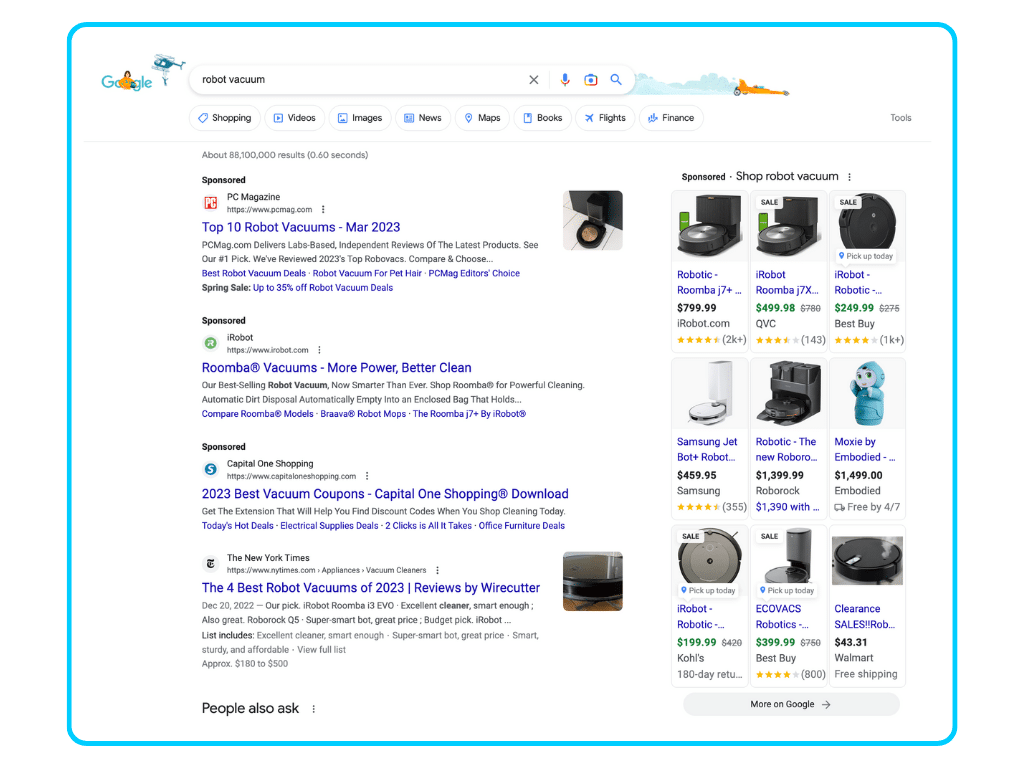
These ads promote local services, such as plumbing or house cleaning, to users in specific geographic areas.
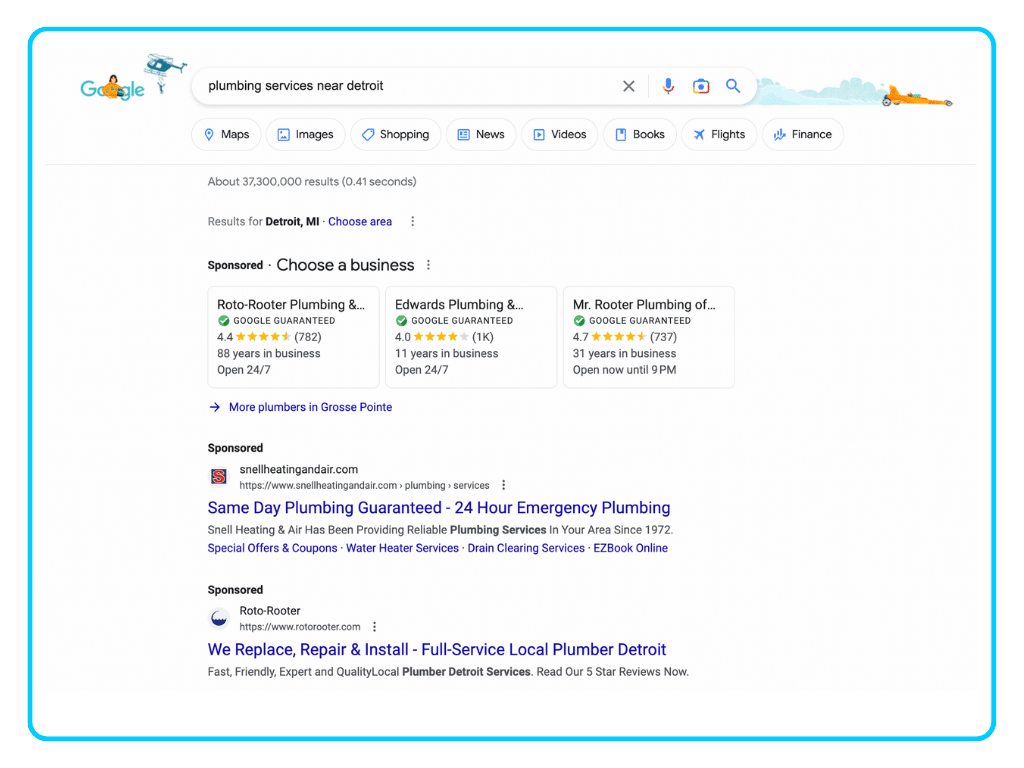
While organic SEO can help get your website on the first page of the search results, paid search campaigns place your business at the coveted top of the page.
Here are some additional benefits of using paid search campaigns:
Branded paid search is a key consumer touchpoint after exposure to other media.
According to a survey conducted by the Out of Home Advertising Association of America (OAAA) and Comscore, searching for information on a search engine was the primary action taken by internet users in the US after viewing ads online (such as display) and offline (such as linear TV and print) channels.
Is paid search a substitute for SEO?
“Paid search complements SEO (more than anything) by driving additional traffic to a website. SEO aims to optimize a website’s content to appear higher in the organic search results, and having a well-optimized, relevant site helps your Quality Score, which ultimately helps you win auctions. Paid search can provide more immediate results, making it useful for promoting specific products or services, while SEO is a long-term strategy requiring ongoing effort.
Also, paid search captures customers at the right moment–when they search for a brand or problem that needs solving.”
According to a survey by Morgan Stanley, Google plays a unique role in the consumer journey compared to other retailers like Amazon.
The survey found that 61% of internet users begin their product research on Google, while only 17% continue using Google after deciding on the product they plan to purchase.
Instead, over half of the respondents (54%) turned to Amazon at that stage. This research suggests that consumers view Google as a starting point for their product research rather than a final destination for their purchase.
What is the most significant advantage of using paid search advertising?
“The most significant advantage of using paid search advertising is the ability to target specific audiences and reach them at the precise moment they are searching for products or services related to your business, ensuring that your message reaches the right people at the right time.”
In 2023, paid search will account for 29.5% of total media ad spending. And by 2026, $3 of every $10 of ad spending will go to search.
eMarketer also predicts paid search will maintain double-digit growth, reaching $111.80 billion of total ad spend, twice what advertisers spent on search in 2019.
Three trends drive the paid search growth surge:
1️⃣ Higher expenditure on search advertising in various ecommerce channels.
Ecommerce search ads are close to the point of purchase and easier to track due to being on the same platform as search and purchase behavior (closed-loop attribution).
2️⃣ Keyword targeting appeal amidst a changing privacy landscape.
Due to intent signals embedded in searches, advertisers can reach interested customers even if Third-Party data isn’t available or sufficient.
3️⃣ Viability of lower-funnel, high-ROI media amid a possible looming recession.
During economic uncertainty, advertisers prioritize lower-funnel media, like paid search, over upper-funnel tactics with less measurable effects on overall revenue.
As the ad industry contends with many uncertainties, paid search thrives.
What emerging trends or changes do you foresee in the paid search advertising landscape in the next few years, and how do you suggest businesses prepare for them?
“So, recent studies show that 40% of Gen Z now prefer to use TikTok as their go-to search engine. This trend suggests that traditional text-based search and display methods are declining, with more emphasis on visual and interactive content, especially video.
In fact, I believe that YouTube Shorts and TikTok are likely to become the primary competitors to Google’s traditional search platform (even though Google owns YouTube). To stay ahead of the curve, businesses can start repurposing their written content into short, engaging videos optimized for platforms like TikTok, YouTube Shorts, and even Instagram Reels. It’s also important to educate themselves on best practices for hashtags and search optimization in these new formats.”
PPC, SEM, and SEO are different aspects of digital advertising and search engine marketing.
PPC (Pay-Per-Click) advertising is an online advertising model where advertisers pay for each click on their ads, which can be displayed on SERPs, social media, and other websites.
SEM (Search Engine Marketing) is a strategy to increase website visibility on search engine results pages using both paid (PPC) and organic (SEO) methods.
SEO (Search Engine Optimization) is optimizing a website to rank higher organically on search engine results pages by improving its content, structure, and coding for better relevance and authority.
What is the biggest mistake you see advertisers make when setting up PPC campaigns?
“The most common mistake I see advertisers make when setting up Google Ads campaigns is location targeting. Google wants you to be inefficient when buying ads so they default the targeting options to worldwide. It’s up the the advertiser to choose which locations to target and exclude. The best practice is to add all of the locations you want to serve your ads individually for better reporting visibility. You also want to make sure to use the ‘in/regularly in’ location targeting settings.”
In this section, we’ll discuss the key steps involved in setting up a paid search campaign, including defining your goals, choosing the right keywords, crafting compelling ad copy, and optimizing your campaign for maximum ROI.
Your Quick Guide to Paid Search Terminology
Common terms used in paid search campaigns include:
In this guide, we’re going to focus on Google Ads, which accounts for over half of the US search advertising market.
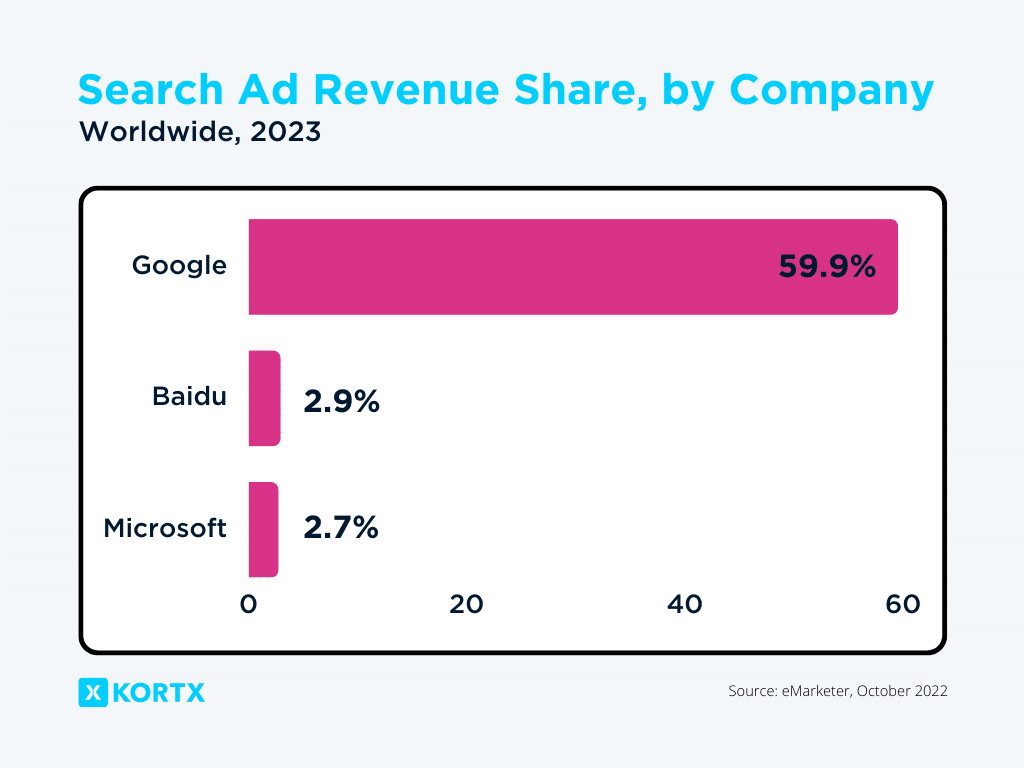
Also, Google maintains a stringent selection process to determine which advertisements it will display for specific keywords. So, you’ll want a Google Ads expert to help you correctly set up your paid search campaign.
Trust our two decades of experience to boost your paid search performance and take your strategy to the next level.
Before creating ads or choosing keywords, you must define your goal with your paid search PPC campaign.
Think about two primary questions:
Your goals will help you determine the right keywords to target, the ad copy to use, and the metrics to track.
How do you measure the success of a paid search advertising campaign, and what metrics do you consider most important?
“ROAS (return on ad spend) is the primary indicator of an advertising campaign’s effectiveness, and setting up proper tracking systems is crucial to measure it accurately. Additionally, monitoring the CPA is important to avoid losing money on conversions. Low conversion rates, CTR, and irrelevant targeting can provide insights into campaign issues like poor copy, irrelevant keywords, or poor targeting. Considering these three metrics can help analyze paid ad campaigns effectively.”
Location settings allow you to target specific geographic areas for your ads to appear. This means that you can select where your ads will be shown based on factors such as country, region, state, city, zip code, or even a specific radius around a location.

A preview of Google location settings.
Keywords are search terms people type into search engines like “seo services detroit” or “best marketing agency near me.”
Find the right keywords for your campaign using keyword research tools like Google’s Keyword Planner, Bing Keyword Research, or Third-Party tools like SEMrush.
You’ll want to choose keywords relevant to your goals, have a high search volume, and are not too competitive.

Keyword planning tools like Google’s Keyword Planner show you the keyword, average monthly searches, how hard it will be to rank for it, and how much it costs.
KORTX’s expert strategy team specializes in developing and executing highly effective paid search strategies to help you achieve your business objectives and reach your target audience.
In paid search advertising, you must choose a match type. Match types tell Google’s algorithm how precise you want your ads to match user searches.
Three different keyword match types impact when your ads display:
1️⃣ Exact Match: Allows your ads to show search queries exactly matching your keyword phrase. In Google Ads, you write it with brackets like [outdoor gear].
When someone searches for outdoor gear, your ads will display only when someone searches for the exact term outdoor gear.
2️⃣ Broad Match: Allows your ads to show for search queries that include any word in your keyword phrase, in any order, and sometimes even synonyms or related searches. In Google Ads, you write it as outdoor gear.
When someone searches for outdoor gear, other related keywords trigger if users search for this phrase in any order, with synonyms like cheap outdoor gear, outdoor gear for camping, and outside gear.
3️⃣ Phrase Match: Allows your ads to show for search queries that include the meaning of your keyword.
The updated Phrase Match combines the expanded reach of Modified Broad Match with the control of Phrase Match.
When someone searches for your keyword phrase in any order, with synonyms like gear for the outdoors, outdoor equipment, outside equipment. But if it changes the meaning of your search, like sports equipment then the ad won’t show.
4️⃣ Negative Match: Allows you to exclude specific search terms from triggering your ads. This is useful to avoid showing your ads for irrelevant searches.
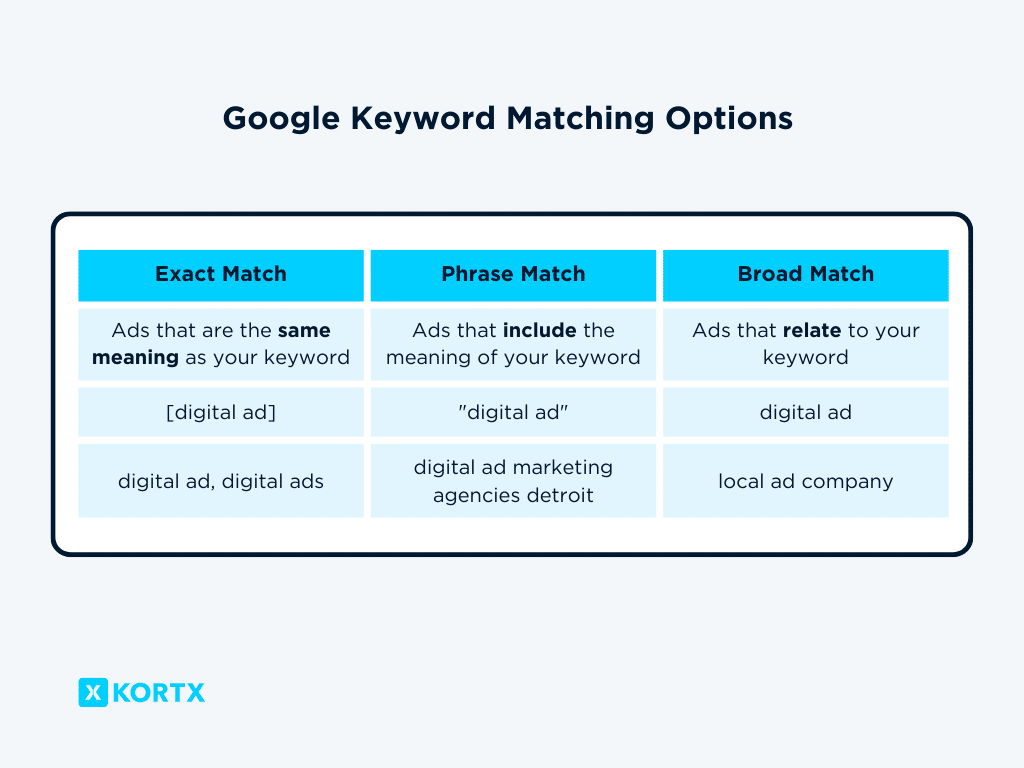
The three keyword match types.
💡 Pro-tip: Use broad match keywords sparingly because your keywords will display hundreds (or maybe thousands) of keyword variations, some irrelevant to the search term, quickly exhausting your budgets without generating sales or inquiries.
Create ads that show when users search for one of your keywords.
Text ads have three primary elements and two optional elements:
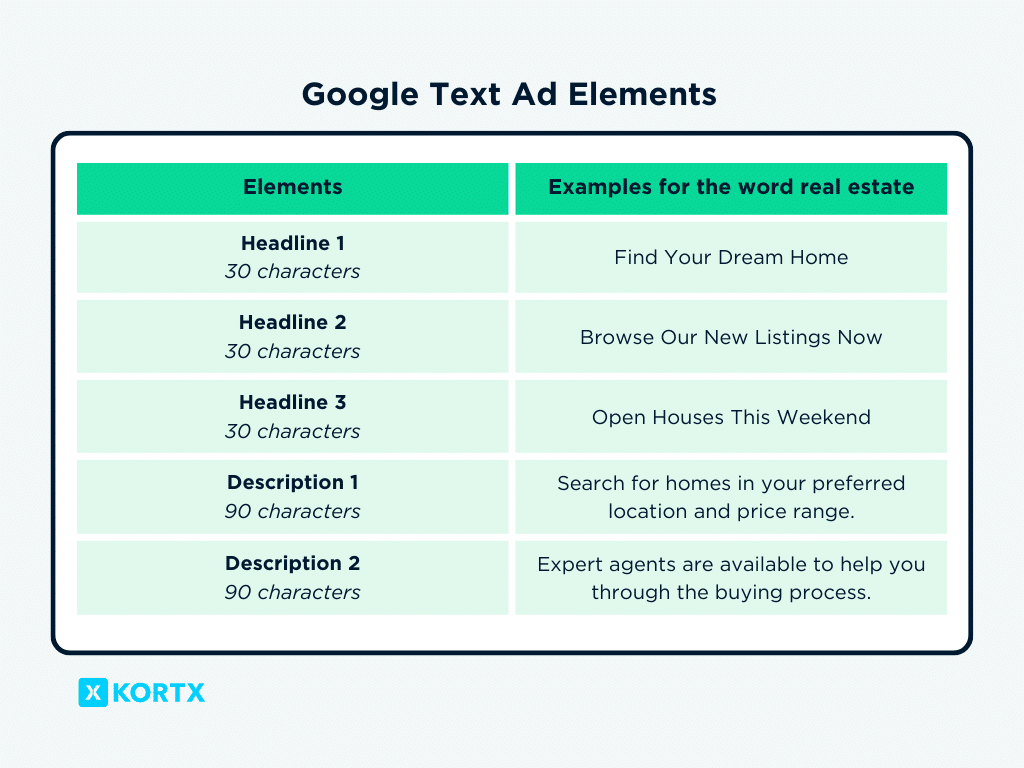
For example, if a user searches for online banking, these Google paid search ads appear:
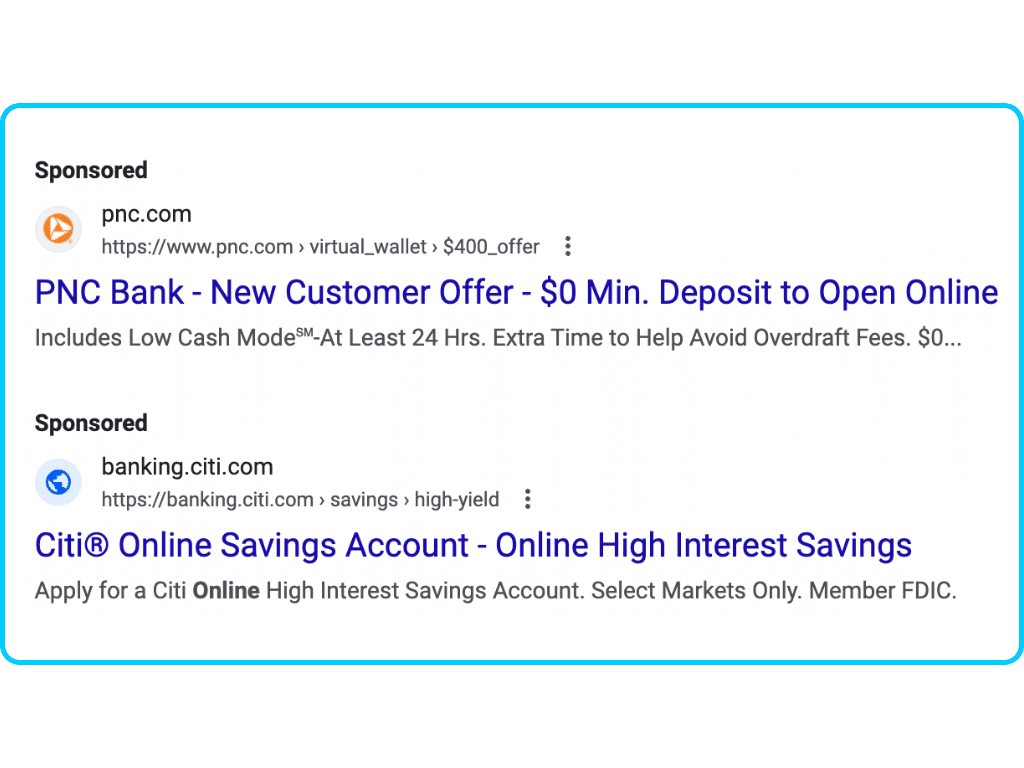
With Google’s new 2022 responsive ad update, you can now write multiple headline and description options. Google will use these combinations to choose the most relevant combination for any search.
Unlike expanded text ads, you can write up to 15 headlines and 4 descriptions for one responsive search ad.
However, Google places strict restrictions on your ad headlines and descriptions, including:
What makes a good ad?
You must entice users to choose you over the other ads or organic listings.
Successful ads contain:
✅ Relevant words and phrases related to your keyword so people can find you.
✅ USPs (unique selling propositions) to differentiate you from competitors and attract potential customers.
✅ Call-to-action to direct users to take a desired action (e.g. clicking through to your website).
✅ Maximize SERP real estate by incorporating paid search extensions (callouts, site links, snippets, etc.)
✅ Incorporate offers in headlines during promotional periods
Settings bids determine the cost of each click and, ultimately, the ad’s placement in the SERPs. You can set bids manually or use AI through Google Ads Smart Bidding algorithms.
Manual bidding is less common than automated bid strategies. It is also limited in its ability to adapt to search volume and performance trends.
What are smart bidding algorithms?
Smart bidding algorithms use Google AI to optimize performance goals, dynamically adjusting bids in real time based on predefined targets. Options include Target CPA, Target ROAS, Maximize Conversions, Maximize Conversion Value, and Enhanced CPC (ECPC).
In manual bidding, you set the maximum amount you’re willing to pay for each click (called the maximum cost-per-click or max CPC) directly on your ad groups or keywords. The final CPC is based on the minimum amount required to meet Ad Rank thresholds and surpass the next highest competitor’s Ad Rank.
Example: If an advertiser wants to target the keyword “digital camera,” they may set a bid of $1.50 for that keyword, but for the keyword “professional DSLR camera,” they can set a bid of $2.50 to increase their chances of winning the auction. This also means they’re more likely to attract users who are most likely to purchase a professional DSLR camera.
Paid search platforms offer suggestions for bidding amounts, but it’s up to you and your budget. If Google Ads recommends a bid of $3.50, but you want to bid $3.00, you can. This may lead to ad placement lower down on the page or less frequently.
What determines ad rank?
When someone searches for your keyword, an auction is held. If your ad wins, it’ll appear in the search results. The ad’s “ad rank” is determined by a combination of bid and quality score.
Quality score evaluates how well your ad, keywords, and landing page match searcher intent on a scale of 1 to 10 (lowest-highest). The highest ad rank receives the first result, with the quality score being calculated based on the following:
The quality score rewards higher-quality ads instead of high-budget advertisers to prevent irrelevant ads from appearing on top of search results.
Ad extensions are additional information you can add to your Google Ads to improve the user experience, increase your quality score, and help your ads take up more space in the SERPs.
Some available ad extension examples include:
Ads usually begin displaying in a few hours, providing you with a quicker opportunity to analyze results in your paid search accounts.
You can pause your paid search ad campaigns at any time to accommodate new promotions, change your budget, or discontinue old campaigns.
What common mistake do businesses often make when implementing a paid search campaign?
“One common mistake businesses make when implementing a paid search campaign is failing to target their ads effectively. To avoid this, businesses should conduct keyword research, use negative keywords, create highly targeted ad groups, and continuously monitor and optimize their campaigns.”
Once your campaign is running, monitor your performance and adjust as needed.
Track your key metrics, such as click-through (CTR) and conversion rates, to see how your ads perform.
If certain keywords or ads are not performing well, consider adjusting bids or tweaking your ad copy.
Check the search term report to see which words users typed into the search engine and saw your ads. If you use broad or phrase-match keywords, perform this check regularly. If you find irrelevant search terms, add them as negative keywords, so you don’t waste your budget.
⚡The key to a successful paid search PPC campaign is ongoing optimization and testing.
Creating effective paid search campaigns is challenging, especially for novices. To help inspire and guide you, this section showcases successful paid search advertising examples from different industries, highlighting the strategies and tactics used to achieve their goals.

Despite budget constraints, sleep Tech sought to enhance its market position in the sleep industry. They teamed up with KORTX, who thoroughly audited their marketing approach. KORTX revamped Sleep Tech’s paid search strategy,
KORTX improved the sleep technology company’s paid search campaign by identifying missed opportunities and restructuring the bidding strategy, marketing tags, geo-targeting, ad groups, keywords, and landing pages. This led to better performance and more conversions.
The company achieved a 23% decrease in average cost per click (CPC), a 505% increase in conversion value to $197, and a 77% decrease in average cost per conversion to $32.50.
These changes laid the foundation for refining the company’s paid social, display, video, and CTV efforts, which KORTX continues to support.
🔎 Read more about the Sleep Tech paid search case study.
This case study highlights the importance of working with digital marketing experts who can help businesses create, implement, and manage efficient paid search programs.

Success is using the right tools and strategies to meet your business goals. One example of this is a quick-service restaurant that partnered with KORTX.
Using KORTX’s comprehensive customer profiling system in Axon Audience Manager, the restaurant reached millions of potential customers and generated over $11 million in online sales with a 5.41X return on ad spend.
However, when the COVID-19 pandemic hit, the restaurant faced a new challenge: 45% of their paid search and social media traffic was dropping off before completing the checkout process.
To tackle this problem head-on, KORTX developed targeted ads for “grab-and-go” options and immunity-boosting products.
Thanks to these creative swaps, the restaurant saw a 13% decrease in drop-off rates, and their ROAS (return on ad spend) continued to exceed their benchmark of 1.5X.
Learn more about our QSR marketing strategy in our guide, 7 QSR Marketing Strategies To Win More Customers Today.
Paid search advertising is a highly effective and well-positioned option for businesses looking to maximize their marketing budgets and generate quick revenue.
While paid search is not a substitute for SEO, it can complement it and provide more immediate results.
Partnering with a paid search expert can also help ensure your paid search campaigns run correctly and maximize every dollar of your ad spend.
So, to boost your online presence and see a quick ROI, you should consider incorporating paid search into your overall digital marketing strategy.
Maximize your SEM campaign success with KORTX’s expert keyword selection and targeting.
Kate Meda is a Copywriter at KORTX. She enjoys omitting needless words and making things sound good.
From us to your inbox weekly.